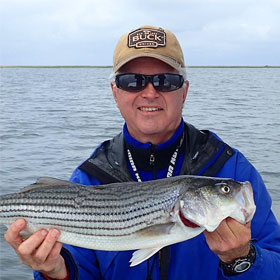Planning a Spring Fishing Trip: Are You Prepared?
By Ken Schultz
Apr 14, 2022
These varied tackle checks should be part of your preparations when planning a spring fishing trip, to ensure that the first one of the season goes smoothly
While some folks fish throughout the year, including winter, the majority don’t get the urge until spring arrives. It’s going to be nice next weekend, I’ve got to go fishing, is a typical thought. Can you just grab your stuff and go? Or do you need to do some planning and prepping? Most of us are in the latter camp.
Planning a Spring Fishing Trip: The First Outing
Ideally, you didn’t just throw your gear in the corner at the end of last season. You backed drag tension off on reels, cleaned gunk off tackle, repaired any broken guides or loose guide footers, checked the state of your line, serviced your reels, and stored all of this out of the sunlight in a stable environment. If you did those things, there’s a good chance you can come out of the starting gate this year and plan the perfect spring fishing trip.
You didn’t? Well, now you need to make the time to check on all of your gear, because the last thing you want is to get to the water and make that first cast, only to find that there’s not enough line on the reel spool, the tip-top guide ring is busted, the reel handle won’t turn, your waders leak, and so forth.
The very least you should do is put a practice casting plug on each of your fishing outfits (yours and your child’s) and make a number of cast-and-retrieves. Also check the drag function on each reel. That way you’ll know if any hiccups might be expected, and you can address them at home, not on the water.
The Most Common Problems
Here are some of the most common things to address when you’re planning a spring fishing trip and checking your gear.
Line
Old line, severely coiled line, and low line levels are typically encountered at the beginning if the season. Replace or add line to the spool and bring it to approximately within an eighth-inch of the spool lip. Take action to remove memory from the line.
Reel drag
Reel drags don’t function properly if they’ve been left in a tightened-down state for a long period of time, a typical problem. A big fish grabs your lure or bait, the drag washers stick and don’t release line in an even manner, and you lose a prized catch.
Reel maintenance
Lubricating your reel enhances casting and retrieving. It is not as important to regularly do in freshwater as in saltwater fishing. Follow the reel manufacturer’s instructions, or take the reel to a tackle shop for maintenance. The only problem with the latter is that in spring, you may have to wait awhile to get your reel back, as so many others are in queue to do the same.
Rod guides
Replace any that are broken or that have nicks in the ceramic rings.
Hooks
Check the state of your bait and lure hooks. If they’re lightly rusted, you can buff them while sharpening and they’ll be fine. If they’re crusty, replace them. Sharpen any dull hooks.
Accessory checks
Put a flashlight inside waders and boots to check for leaks; make sure your pliers and fish gripper are functioning; and take time to clean out and re-organize your tackle storage devices, which will also help you find what you need quickly on that first outing.
Boating matters
If you’ll be using a boat, there’s a another whole set of checkups to do, and you have to make time for them as well.
Most Importantly
Your fishing license is current, right? Don’t speculate about this. Dig your license out and check to see if it has expired, or when it will.









